您现在的位置是:首页 >技术教程 >顺序表(更新版)——“数据结构与算法”网站首页技术教程
顺序表(更新版)——“数据结构与算法”
各位CSDN的uu们你们好呀,今天小雅兰又来更新新专栏啦,其实之前我就已经写过了顺序表的内容,只是之前的内容不是最新版的顺序表,现在,我来更新一下最新版的顺序表,下面,就让我们进入更新版的顺序表的世界吧
顺序表和小雅兰之前写的三子棋、扫雷、通讯录一样,分为三个文件:
https://xiaoyalan.blog.csdn.net/article/details/128705747?spm=1001.2014.3001.5502
https://xiaoyalan.blog.csdn.net/article/details/128717749?spm=1001.2014.3001.5502
https://xiaoyalan.blog.csdn.net/article/details/128717749?spm=1001.2014.3001.5502
https://xiaoyalan.blog.csdn.net/article/details/129788167?spm=1001.2014.3001.5502
https://xiaoyalan.blog.csdn.net/article/details/129896970?spm=1001.2014.3001.5502
test.c——测试代码功能
SeqList.c——顺序表的实现
SeqList.h——顺序表的声明
https://xiaoyalan.blog.csdn.net/article/details/129380414?spm=1001.2014.3001.5502
这是小雅兰之前写的顺序表的知识,有兴趣的可以去看看
我们写的是一个动态版的顺序表:
typedef struct SeqList { SLDataType* a; int size;//存储的有效数据的个数 int capacity;//容量 }SL;把struct SeqList这个结构体重命名为SL
typedef int SLDataType;把int重命名为SLDataType
写成这样的形式是因为:如果以后想要修改类型,那就直接改int就可以了,如果不这样写, 要改很多个地方,就很麻烦
顺序表的初始化:
//初始化 void SLInit(SL* ps1) { ps1->a = malloc(sizeof(SLDataType) * 4); if (ps1 == NULL) { perror("malloc fail"); return; } ps1->size = 0; ps1->capacity = 4; }动态开辟出4个SLDataType类型的大小的空间
顺序表的销毁:也就是把空间还给操作系统
//销毁 //把空间还给操作系统 void SLDestroy(SL* ps1) { free(ps1->a); ps1->a = NULL; ps1->size = 0; ps1->capacity = 0; }
打印顺序表的内容:
//打印 void SLPrint(SL* ps1) { int i = 0; for (i = 0; i < ps1->size; i++) { printf("%d ", ps1->a[i]); } printf(" "); }
尾插:
ps1->a[ps1->size] = x; ps1->size++;在这里,我们需要想一个问题:在尾插的过程中,如果空间不够了该怎么办呢???所以在这里,我们还需要一个检查容量的函数,如果容量不够就扩容
//检查容量,容量不够就扩容 void SLCheckCapacity(SL* ps1) { if (ps1->size == ps1->capacity) { SLDataType* tmp = (SLDataType*)realloc(ps1->a, sizeof(SLDataType) * ps1->capacity * 2); //扩上一个二倍大小的容量 //这个数值可以自己设定,扩多了不好,扩少了也不好 //所以扩上二倍是最合理的选择 if (tmp == NULL) { perror("realloc fail"); return; } ps1->a = tmp; ps1->capacity = ps1->capacity * 2; } }//尾插 void SLPushBack(SL* ps1, SLDataType x) { SLCheckCapacity(ps1); ps1->a[ps1->size] = x; ps1->size++; }
下面,我们来测试一下尾插的功能,看是否成功
int main()
{
SL s;
SLInit(&s);
SLPushBack(&s, 1);
SLPushBack(&s, 2);
SLPushBack(&s, 3);
SLPushBack(&s, 4);
SLPushBack(&s, 5);
SLPushBack(&s, 6);
SLPushBack(&s, 7);
SLPushBack(&s, 8);
SLPushBack(&s, 9);
SLPushBack(&s, 10);
SLPrint(&s);
SLDestroy(&s);
return 0;
}

结果发现,尾插的功能非常成功!!!
头插:
需要从后往前挪动数据!!!
若是从前往后挪动数据,就会覆盖,这是绝对不行的
//头插 void SLPushFront(SL* ps1, SLDataType x) { SLCheckCapacity(ps1); //挪动数据 int end = ps1->size - 1; while (end >= 0) { ps1->a[end + 1] = ps1->a[end];//把数据往后挪 end--; } ps1->a[0] = x; ps1->size++; }
来测试一下头插的功能:
//头插测试
void TestSeqList2()
{
SL s;
SLInit(&s);
SLPushBack(&s, 1);
SLPushBack(&s, 2);
SLPushBack(&s, 3);
SLPushBack(&s, 4);
SLPushFront(&s, 5);
SLPushFront(&s, 6);
SLPushFront(&s, 7);
SLPushFront(&s, 8);
SLPushFront(&s, 9);
SLPrint(&s);
SLDestroy(&s);
} 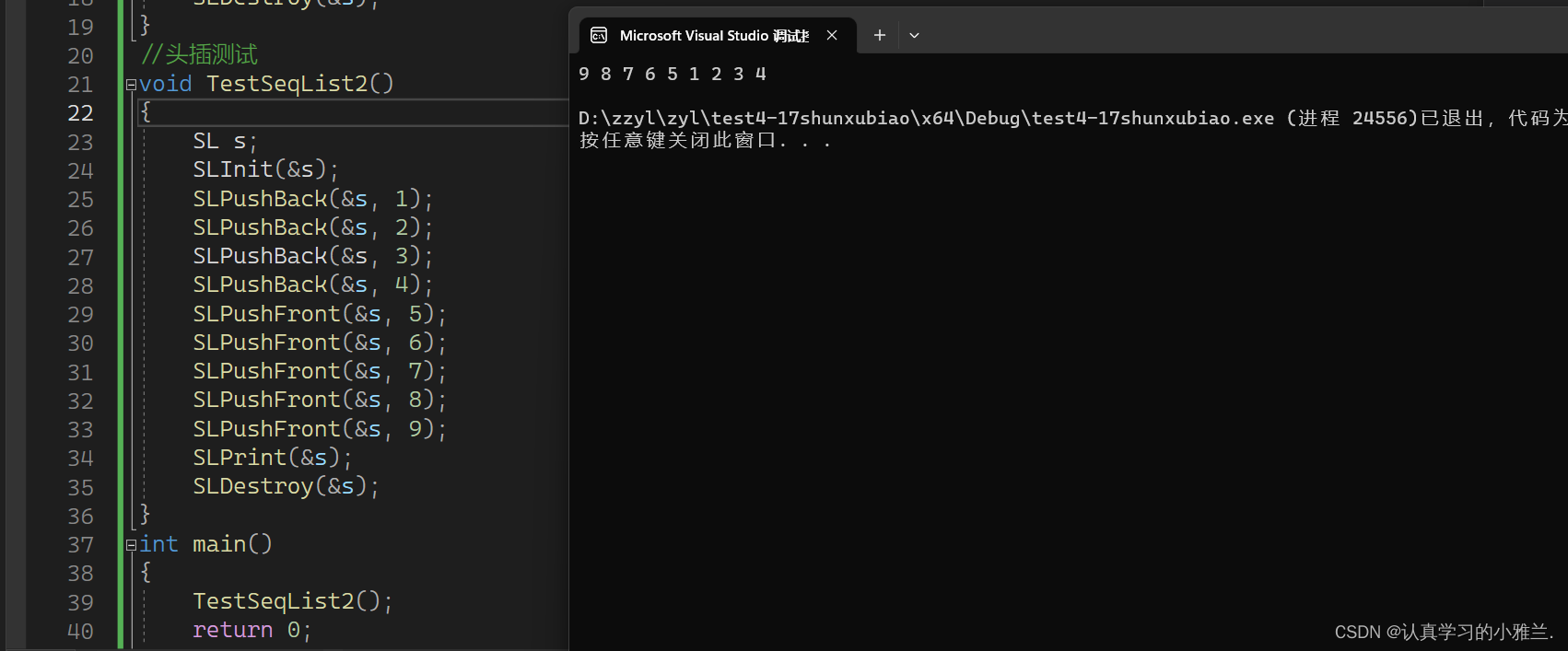
尾删:
直接把size--就可以了
//尾删 void SLPopBack(SL* ps1) { ps1->size--; }
来测试一下尾删的功能:
//尾删测试
void TestSeqList3()
{
SL s;
SLInit(&s);
SLPushBack(&s, 1);
SLPushBack(&s, 2);
SLPushBack(&s, 3);
SLPushBack(&s, 4);
SLPushFront(&s, 5);
SLPushFront(&s, 6);
SLPushFront(&s, 7);
SLPushFront(&s, 8);
SLPushFront(&s, 9);
SLPrint(&s);
SLPopBack(&s);
SLPopBack(&s);
SLPopBack(&s);
SLPrint(&s);
SLDestroy(&s);
}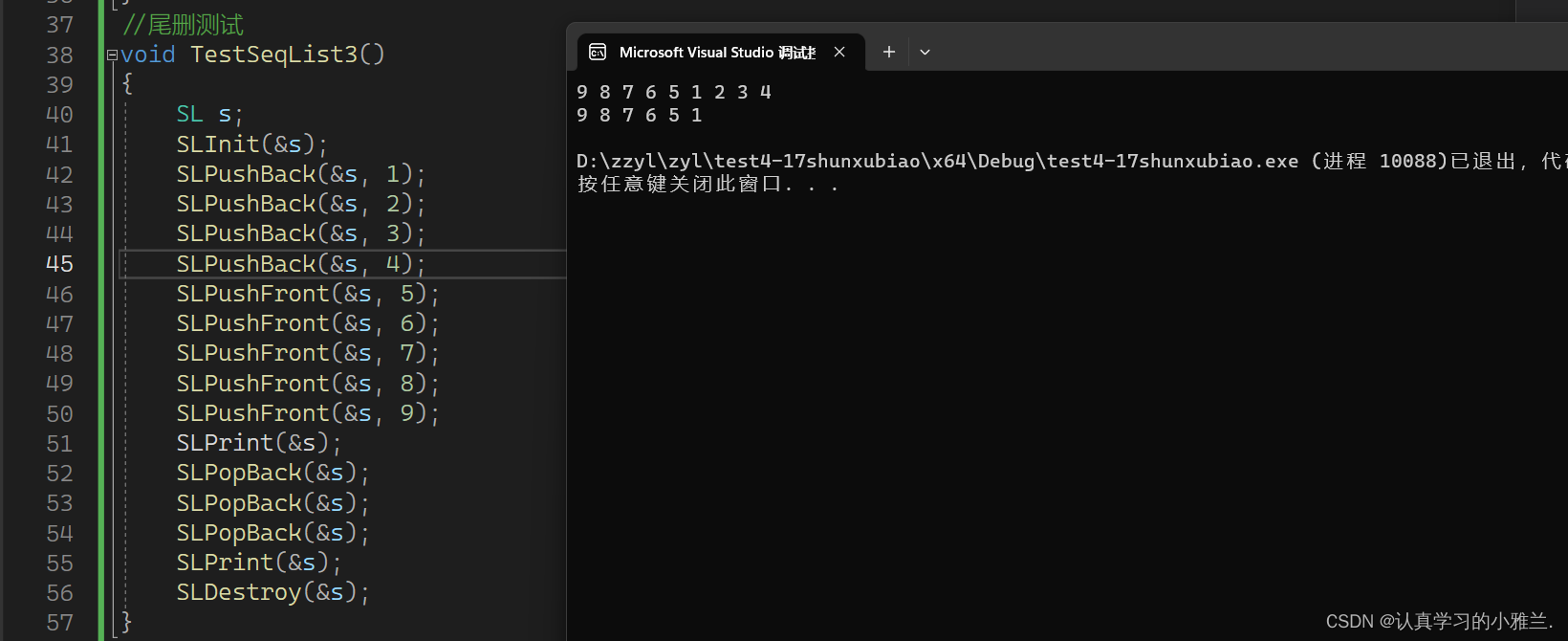
但是这个尾删仍然有点问题,需要检查一下:
//尾删 void SLPopBack(SL* ps1) { //温柔的检查 if (ps1->size == 0) { return; } ps1->size--; }//尾删 void SLPopBack(SL* ps1) { //暴力的检查 assert(ps1->size > 0); ps1->size--; }
头删:
//头删 void SLPopFront(SL* ps1) { //暴力检查 assert(ps1->size > 0); int start = 0; while (start < ps1->size - 1) { ps1->a[start] = ps1->a[start + 1]; start++; } ps1->size--; }
来测试一下头删的功能:
//头删测试
void TestSeqList4()
{
SL s;
SLInit(&s);
SLPushBack(&s, 1);
SLPushBack(&s, 2);
SLPushBack(&s, 3);
SLPushBack(&s, 4);
SLPushFront(&s, 5);
SLPushFront(&s, 6);
SLPushFront(&s, 7);
SLPushFront(&s, 8);
SLPushFront(&s, 9);
SLPrint(&s);
SLPopBack(&s);
SLPopBack(&s);
SLPopBack(&s);
SLPrint(&s);
SLPopFront(&s);
SLPopFront(&s);
SLPopFront(&s);
SLPrint(&s);
SLDestroy(&s);
} 
在中间位置插入数据:
//在中间位置(pos)插入数据 void SLInsert(SL* ps1, int pos, SLDataType x) { SLCheckCapacity(ps1); int end = ps1->size - 1; while (end >= pos) { ps1->a[end + 1] = ps1->a[end]; end--; } ps1->a[pos] = x; ps1->size++; }
写了这个函数的功能之后,我们就可以把之前写的头插和尾插修改一下:
//尾插 void SLPushBack(SL* ps1, SLDataType x) { SLInsert(ps1, ps1->size, x); }//头插 void SLPushFront(SL* ps1, SLDataType x) { SLInsert(ps1, 0, x); }
但是,这个在中间插入数据的代码还是有点问题;
//中间插数据测试
void TestSeqList5()
{
SL s;
SLInit(&s);
SLPushBack(&s, 1);
SLPushBack(&s, 2);
SLPushBack(&s, 3);
SLPushBack(&s, 4);
SLPushFront(&s, 5);
SLPushFront(&s, 6);
SLPushFront(&s, 7);
SLPushFront(&s, 8);
SLPushFront(&s, 9);
SLPrint(&s);
SLPopBack(&s);
SLPopBack(&s);
SLPopBack(&s);
SLPrint(&s);
SLPopFront(&s);
SLPopFront(&s);
SLPopFront(&s);
SLPrint(&s);
SLInsert(&s, 2, 30);
SLPrint(&s);
SLInsert(&s, 20, 300);
SLPrint(&s);
SLDestroy(&s);
}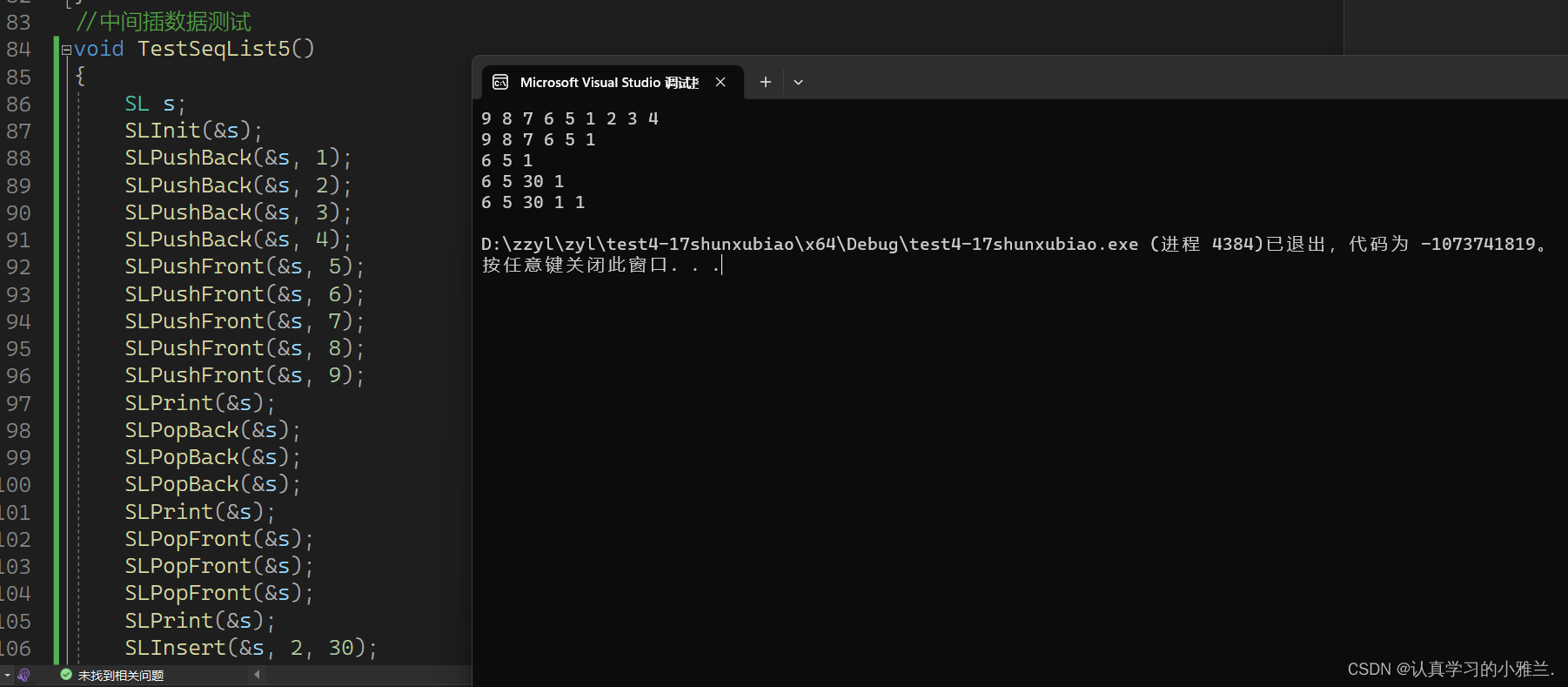
从此运行结果可知:越界是不会报错的!!!但是它的的确确越界了!!!
所以把代码改进为:
//在中间位置(pos)插入数据 void SLInsert(SL* ps1, int pos, SLDataType x) { assert(pos >= 0 && pos <= ps1->size); SLCheckCapacity(ps1); int end = ps1->size - 1; while (end >= pos) { ps1->a[end + 1] = ps1->a[end]; end--; } ps1->a[pos] = x; ps1->size++; }
在中间位置删除数据:
//在中间位置(pos)删除数据 void SLErase(SL* ps1, int pos) { assert(pos >= 0 && pos < ps1->size); assert(ps1->size > 0);//可有可无 int start = pos + 1; while (start <= pos + 1) { ps1->a[start - 1] = ps1->a[start]; start++; } ps1->size--; }
同样,有了这个功能之后,可以把头删和尾删修改一下:
//头删 void SLPopFront(SL* ps1) { SLErase(ps1, 0); }//尾删 void SLPopBack(SL* ps1) { SLErase(ps1, ps1->size - 1); }
测试一下从中间删除数据的功能:
//中间删数据测试
void TestSeqList6()
{
SL s;
SLInit(&s);
SLPushBack(&s, 1);
SLPushBack(&s, 2);
SLPushBack(&s, 3);
SLPushBack(&s, 4);
SLPushFront(&s, 5);
SLPushFront(&s, 6);
SLPushFront(&s, 7);
SLPushFront(&s, 8);
SLPushFront(&s, 9);
SLPrint(&s);
SLPopBack(&s);
SLPopBack(&s);
SLPopBack(&s);
SLPrint(&s);
SLPopFront(&s);
SLPopFront(&s);
SLPopFront(&s);
SLPrint(&s);
SLInsert(&s, 2, 30);
SLPrint(&s);
SLErase(&s, 3);
SLPrint(&s);
SLDestroy(&s);
} 
查找:
//查找 //找到了返回下标,找不到返回-1 int SLFind(SL* ps1, SLDataType x) { int i = 0; for (i = 0; i < ps1->size; i++) { if (ps1->a[i] == x) { return i; } } return -1; }
修改:
//修改 void SLModify(SL* ps1, int pos, SLDataType x) { assert(pos >= 0 && pos < ps1->size); ps1->a[pos] = x; }
下面,浅浅附上一波源代码:
SeqList.c的内容
#include"SeqList.h"
//初始化
void SLInit(SL* ps1)
{
assert(ps1);
ps1->a = malloc(sizeof(SLDataType) * 4);
if (ps1 == NULL)
{
perror("malloc fail");
return;
}
ps1->size = 0;
ps1->capacity = 4;
}
//销毁
//把空间还给操作系统
void SLDestroy(SL* ps1)
{
assert(ps1);
free(ps1->a);
ps1->a = NULL;
ps1->size = 0;
ps1->capacity = 0;
}
//打印
void SLPrint(SL* ps1)
{
assert(ps1);
int i = 0;
for (i = 0; i < ps1->size; i++)
{
printf("%d ", ps1->a[i]);
}
printf("
");
}
//检查容量,容量不够就扩容
void SLCheckCapacity(SL* ps1)
{
assert(ps1);
if (ps1->size == ps1->capacity)
{
SLDataType* tmp = (SLDataType*)realloc(ps1->a, sizeof(SLDataType) * ps1->capacity * 2);
//扩上一个二倍大小的容量
//这个数值可以自己设定,扩多了不好,扩少了也不好
//所以扩上二倍是最合理的选择
if (tmp == NULL)
{
perror("realloc fail");
return;
}
ps1->a = tmp;
ps1->capacity = ps1->capacity * 2;
}
}
//在中间位置(pos)插入数据
void SLInsert(SL* ps1, int pos, SLDataType x)
{
assert(ps1);
assert(pos >= 0 && pos <= ps1->size);
SLCheckCapacity(ps1);
int end = ps1->size - 1;
while (end >= pos)
{
ps1->a[end + 1] = ps1->a[end];
end--;
}
ps1->a[pos] = x;
ps1->size++;
}
//在中间位置(pos)删除数据
void SLErase(SL* ps1, int pos)
{
assert(ps1);
assert(pos >= 0 && pos < ps1->size);
assert(ps1->size > 0);//可有可无
int start = pos + 1;
while (start <= pos + 1)
{
ps1->a[start - 1] = ps1->a[start];
start++;
}
ps1->size--;
}
//尾插
void SLPushBack(SL* ps1, SLDataType x)
{
assert(ps1);
/*SLCheckCapacity(ps1);
ps1->a[ps1->size] = x;
ps1->size++;*/
SLInsert(ps1, ps1->size, x);
}
//头插
void SLPushFront(SL* ps1, SLDataType x)
{
assert(ps1);
//SLCheckCapacity(ps1);
挪动数据
//int end = ps1->size - 1;
//while (end >= 0)
//{
// ps1->a[end + 1] = ps1->a[end];//把数据往后挪
// end--;
//}
//ps1->a[0] = x;
//ps1->size++;
SLInsert(ps1, 0, x);
}
//尾删
void SLPopBack(SL* ps1)
{
assert(ps1);
温柔的检查
//if (ps1->size == 0)
//{
// return;
//}
//ps1->size--;
//暴力的检查
/*assert(ps1->size > 0);
ps1->size--;*/
SLErase(ps1, ps1->size - 1);
}
//头删
void SLPopFront(SL* ps1)
{
assert(ps1);
//暴力检查
assert(ps1->size > 0);
int start = 0;
while (start < ps1->size - 1)
{
ps1->a[start] = ps1->a[start + 1];
start++;
}
ps1->size--;
//SLErase(ps1, 0);
}
//查找
//找到了返回下标,找不到返回-1
int SLFind(SL* ps1, SLDataType x)
{
assert(ps1);
int i = 0;
for (i = 0; i < ps1->size; i++)
{
if (ps1->a[i] == x)
{
return i;
}
}
return -1;
}
//修改
void SLModify(SL* ps1, int pos, SLDataType x)
{
assert(ps1);
assert(pos >= 0 && pos < ps1->size);
ps1->a[pos] = x;
}
SeqList.h的内容
#pragma once
#include<stdio.h>
#include<stdlib.h>
#include<assert.h>
//动态顺序表
typedef int SLDataType;
typedef struct SeqList
{
SLDataType* a;
int size;//存储的有效数据的个数
int capacity;//容量
}SL;
//初始化
void SLInit(SL* ps1);
//销毁
//把空间还给操作系统
void SLDestroy(SL* ps1);
//打印
void SLPrint(SL* ps1);
//尾插
void SLPushBack(SL* ps1,SLDataType x);
//尾删
void SLPopBack(SL* ps1);
//头插
void SLPushFront(SL* ps1, SLDataType x);
//头删
void SLPopFront(SL* ps1);
//在中间位置(pos)插入数据
void SLInsert(SL* ps1, int pos, SLDataType x);
//在中间位置(pos)删除数据
void SLErase(SL* ps1, int pos);
//查找
//找到了返回下标,找不到返回-1
int SLFind(SL* ps1, SLDataType x);
//修改
void SLModify(SL* ps1, int pos, SLDataType x);
test.c的内容
void menu()
{
printf("***********************************************************
");
printf("1、尾插数据 2、尾删数据
");
printf("
");
printf("3、头插数据 4、头删数据
");
printf("
");
printf("5、在任意位置插入数据(位置3插入20)
");
printf("
");
printf("6、在任意位置删除数据
");
printf("
");
printf("7、查找某个数据的位置,并删除它
");
printf("
");
printf("8、删除顺序表中有的 某个数据
");
printf("
");
printf("9、打印数据
");
printf("
");
printf("-1、退出
");
printf("
");
printf("***********************************************************
");
}
int main()
{
printf("************* 欢迎大家来到动态顺序表的测试 **************
");
int option = 0;
SL s;
SLInit(&s);
do
{
menu();
printf("请输入你的操作:>");
scanf_s("%d", &option);
int sum = 0;
int x = 0;
int y = 0;
int z = 0;
int pos = 0;
int w = 0;
switch (option)
{
case 1:
printf("请依次输入你要尾插的数据:,以-1结束
");
scanf_s("%d", &sum);
while (sum != -1)
{
SLPushBack(&s, sum); // 1.尾插
scanf_s("%d", &sum);
}
break;
case 2:
SLPopBack(&s); // 2.尾删
break;
case 3:
scanf_s("%d", &x);
SLPushFront(&s, x); // 3.头插
break;
case 4:
SLPopFront(&s); // 4.头删
break;
case 5:
SLInsert(&s, 3, 20); // 5.在任意位置插入数据
break;
case 6:
SLErase(&s, 3); // 6.在任意位置删除数据
break;
case 7:
printf("请输入要删除序列的中的某个数字
");
scanf_s("%d", &z);
y = SLFind(&s, z); // 7.查找某个数字的位置,并且删除它
printf("%d的位置在%d处:
", z, y);
if (y != -1)
{
SLErase(&s, y);
}
break;
case 8:
printf("请输入要删除序列的中的数字
"); //8.删除顺序表中 所有的 某个数据
scanf_s("%d", &w);
pos = SLFind(&s, w, 0);
while (pos != -1)
{
SLErase(&s, pos);
pos = SLFind(&s, w, pos);
}
break;
case 9:
SLPrint(&s);
break;
default:
if (option == -1)
{
exit(0); // 退出程序
}
else
{
printf("输入错误,请重新输入
");
}
break;
}
} while (option != -1); // 退出程序
SLDestroy(&s);
return 0;
}好啦,小雅兰今天的顺序表的更新版的内容就到这里啦,继续加油刷题和学习算法噢!!!


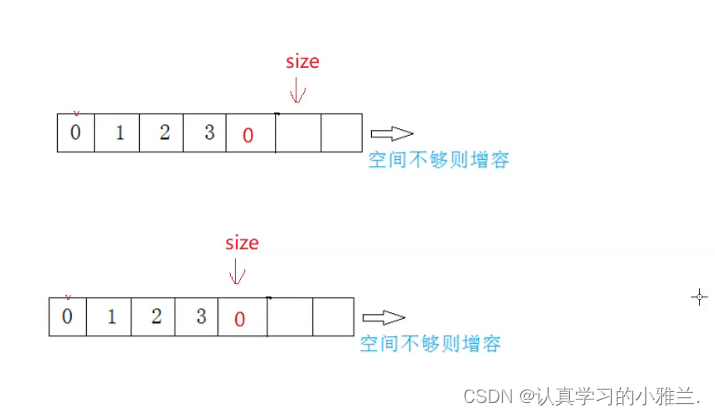
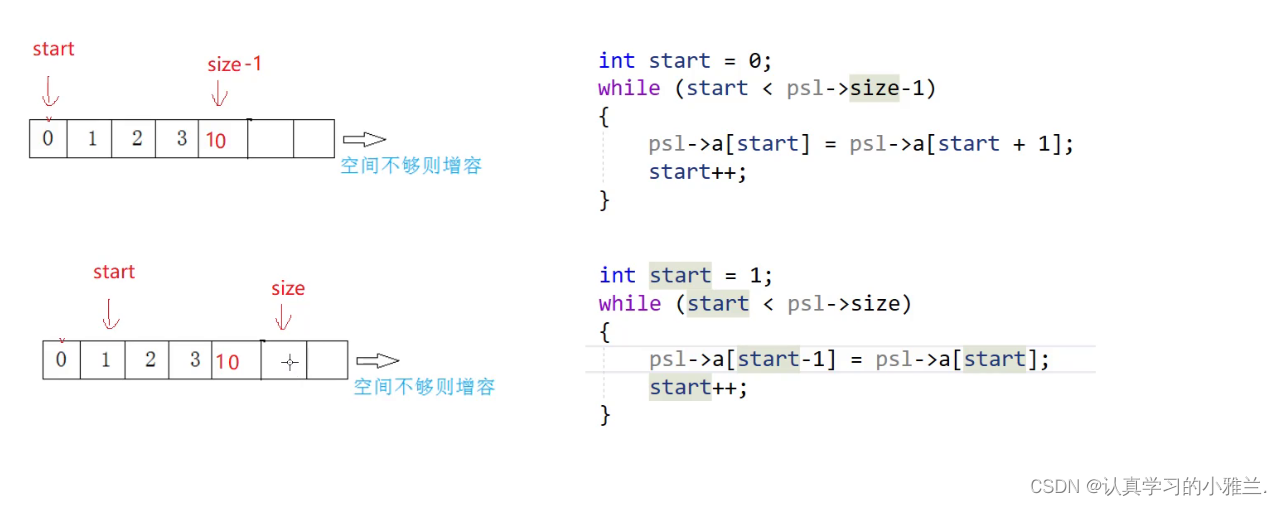
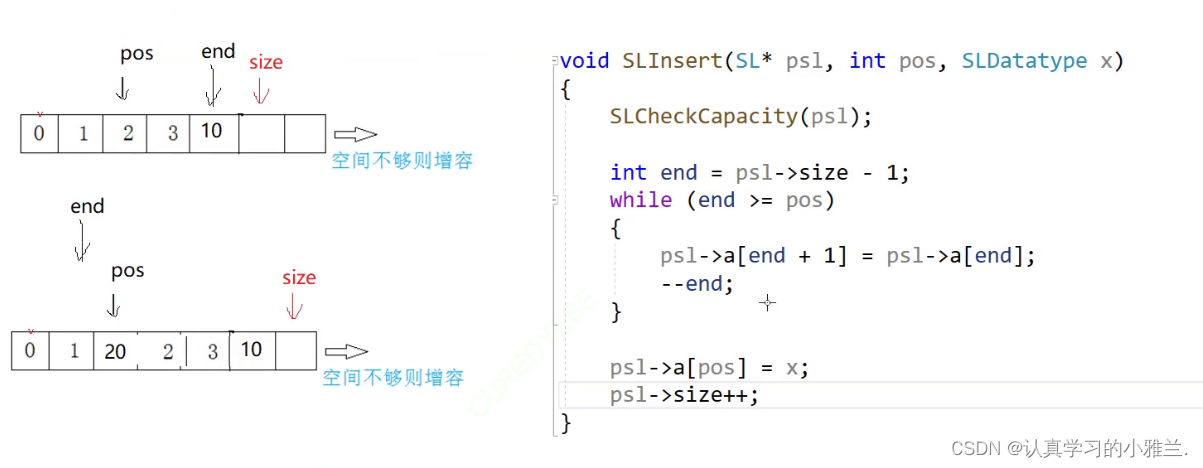






 U8W/U8W-Mini使用与常见问题解决
U8W/U8W-Mini使用与常见问题解决 QT多线程的5种用法,通过使用线程解决UI主界面的耗时操作代码,防止界面卡死。...
QT多线程的5种用法,通过使用线程解决UI主界面的耗时操作代码,防止界面卡死。... stm32使用HAL库配置串口中断收发数据(保姆级教程)
stm32使用HAL库配置串口中断收发数据(保姆级教程) 分享几个国内免费的ChatGPT镜像网址(亲测有效)
分享几个国内免费的ChatGPT镜像网址(亲测有效) Allegro16.6差分等长设置及走线总结
Allegro16.6差分等长设置及走线总结